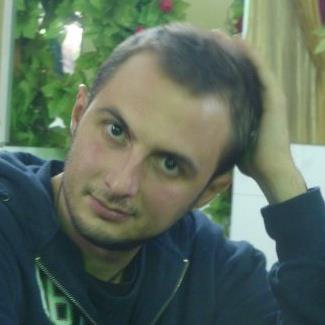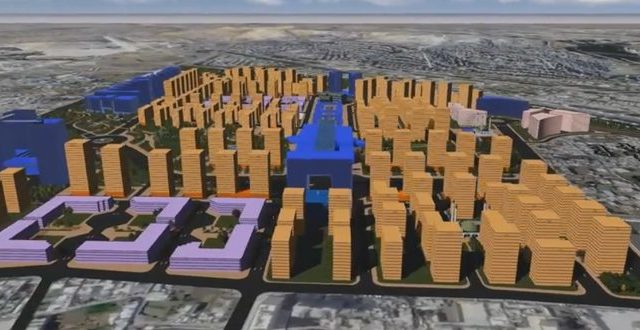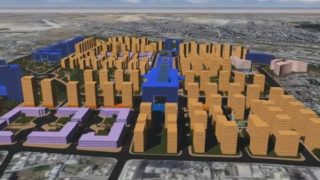How the process of rebuilding Syria will be used to reimpose the regime’s power domestically and regionally.
The topic of post-war reconstruction has increased in prominence within the debate on the Syrian conflict over the past year. Reports evaluating plans and costs to rebuild the country have been published by several international organizations. Estimates of the costs are shocking: between $200 and $400 billion are needed to return to the country to its pre-war levels of economic and social development. The debate has focused on the policies and the measures to be implemented in order to collect this huge amount of money and to channel it into credible and sustainable reconstruction projects.
Immediately, two, apparently unsolvable, problems have been raised by analysts. First, the Assad regime – which has emerged as the victor of the conflict – is too internationally isolated to obtain enough funds. Its main allies, Russia and Iran, do not have the resources to significantly contribute. On the contrary, they have been competing to obtain shares of the already limited natural resources of Syria. Meanwhile, better financially endowed international actors, such as Western countries and rich Arab monarchies, do not seem keen to take part in the financial effort without a credible political transition. Second, to rebuild the country the regime needs manpower. However, most working-age men – when they are not enrolled in the army or in the numerous pro-regime militias – are currently either refugees abroad or in rebel-held areas. Data and surveys show that most of them are not keen to return to their country or in regime-held territories in the foreseeable future. Lack of services and fear of regime reprisals are the main reasons they give. Most of them come from areas and cities where inhabitants participated massively in the uprising. They are afraid that the regime will be wary of these citizens, it will keep strict control on them and possibly arrest those suspected of having had links to the rebellion. Moreover, they fear that the regime will keep these areas at the margins of reconstruction effort, limiting the resources channeled into them and perpetuating high unemployment and poor services for the years to come.
While describing these two major problems, analysts stress the fact that the regime has also implemented measures exacerbating such obstacles. For instance, Assad has explicitly declared that he does not want Western countries and their companies to take part in the reconstruction. The regime has granted priority in major projects to Iranian and Russian companies and promised to do the same throughout the reconstruction process. Last year representatives of Damascus and Teheran signed various agreements granting Iranian entities access to rebuild crucial sectors such as the defense industry and to establish a new phone company on Syrian territory. Meanwhile, Russia secured exclusive access to the Syrian hydrocarbons and phosphate resources. Moreover, the regime has introduced legislative measures – such as Law 10 or a limited amnesty for army deserters that still compels them to join the military once back – that most analysts consider as aimed at expropriating a significant share of Syrians living abroad and to discourage them to return. Observers have usually attributed such decisions to Assad’s shortsighted policy intended to repay its domestic and international allies while ignoring and postponing serious plans regarding the country’s reconstruction and the return of refugees.
Related articles
26 July 2018
Starting in 2011, Bashar al-Assad’s government has passed a number of laws that undermined the status of the displaced population, preventing many from claiming title to land that was once...
A small-scale reconstruction is not just aimed at making the regime’s power more stable through the exclusion of problematic constituencies. Another primary goal is to keep the process managed by the regime with as much autonomy as possible. The reasons for this are twofold: first, a large-scale reconstruction process involving great amounts of money, planning, and a multitude of diverse actors involved would be hardly manageable by the Syrian state given the poor status of its institutions. Eight years of war have depleted the state’s expertise, exacerbated corruption and mismanagement, and fragmented its structure into multiple informal power centers. A reconstruction process of large scale would be unmanageable for the Syrian state and would lead the regime to rely, once again, on its main allies, especially on Moscow, allowing them to expand their already cumbersome foothold within Syrian institutions.
Furthermore, a large-scale reconstruction process would also require major diplomatic initiatives in order to gather sufficient international support. This too would require external actors to play a crucial role. In October 2018 Russia and Turkey hosted in Istanbul German Chancellor Angela Merkel and French President Emmanuel Macron, in a first attempt to build this kind of large-scale diplomatic initiative on post-war Syria. Over the last years, both Moscow and Ankara have used their strategic role in the Syrian crisis as bargaining chip in their own disputes with the West. The reconstruction would represent another major occasion to do so by acting as mediators and facilitators between key international powers and the main actors on the ground, namely the regime and the Turkey-sponsored opposition. Once again, this would make Damascus dependent on diplomatic initiatives managed by others and the subject of potential conditions and impositions not directly negotiated by the Syrian government. When similar circumstances occurred in the past, the regime has already shown its scarce tolerance for external pressure, even when it has been exerted by its close allies. Hence, in the next months and years we should expect the regime to engage in smaller, bilateral diplomatic initiatives allowing it to bypass its allies (and foes) as much as possible.
At the international level, this bilateral approach is unlikely to achieve great success, especially in terms of securing financial support. Beyond Russia, the only major power the regime maintains direct links with is China, which has so far shown scarce interest in playing a great role in the reconstruction. Also, some major European countries – such as Italy and Austria – may soon reestablish normal diplomatic relations with Damascus. Their new, nationalistic governments have shown sympathy for the Assad regime and in the future their support may be crucial to lift, or at least lighten, the EU sanctions on Syria. However, it would be wrong to expect from these governments more than diplomatic normalization. In fact, their nationalist, “America-first-style” approach would hardly lead them to disburse major resources in favor of other countries.
The regime may have more room for maneuvers with regional powers. In particular, it could use in its favor the unique strategic role that post-war Syria is going to play within the new and old regional divides. The surprising news regarding the reopening of the UAE and Bahrein’s embassies in Damascus at the end of 2018 – which may be soon followed by the reopening of the Saudi embassy – marked a first step in this direction. Over the previous years, Gulf monarchies had all supported – although to different extents – diverse groups within the Syrian opposition. Their U-turn in favor of Assad has been mostly explained as an attempt to curb Iranian influence in the country by luring the regime on their side using reconstruction money. However, although the Iran-factor certainly plays a role, the improving relations between the Syrian regime and some Gulf monarchies should be understood in the framework of the post-Arab Spring strategy employed by these countries.
Over the past eight years Riyadh and Abu Dhabi have actively pushed back against the expansion of the Muslim-Brotherhood brand of political Islam, which in the immediate aftermath of the 2011 uprisings had appeared as the new prevailing political trend across the region. In doing so, they have put aside their support for more conservative, Salafi groups and focused primarily on backing strong military men, such as General Abdel Fattah el-Sisi in Egypt and Colonel Khalifa Haftar in Libya. The secular look of these individuals, coupled with their rhetoric prioritizing stability and security (usually at the expense of political and human rights), could more easily find support also outside the Muslim world, especially in some Western capitals and in Moscow. Seen through this lens, the Assad regime fits quite well the kind of Arab leadership that Riyadh and Abu Dhabi have shown to favor lately. Today Damascus is on the front line against opposition groups actively supported by Turkey and Qatar, the two international sponsors of the Muslim Brotherhood. Recent moves by Saudi Arabia and UAE – such as the economic and political embargo imposed on Qatar in 2017 and the recent rift between Riyadh and Turkey over the Khashoggi case – have shown that their leaderships have come to consider the Qatari and Turkish policies in the region as a threat comparable to – if not greater than – the Iranian one.
Over the next years Damascus is posed to play an ambiguous, yet potentially advantageous, role in regional politics: on the Iranian side in the traditional rift between Western-allied Gulf monarchies and Iran and on Riyadh and Abu Dhabi’s side in the new rift between them and the de-facto Turkish-Qatari alliance. This may allow Assad to play the protagonists of these overlapping divides one against the other, obtaining military and political backing from Iran and Hezbollah when needed while also obtaining economic support from the Gulf monarchies, preoccupied of guaranteeing Assad’s stability against Turkey-sponsored Islamist rebels. More importantly, if well played, such a role would mark the comeback of Syria’s influence in the region after eight years of absence and limit the capability of both Moscow and Teheran to impose their regional strategies on Damascus.
Most of the recent debate on post-war reconstruction departs from two main notions: first, that the process will aim to return Syria and its society to their pre-war status; second, that to achieve that goal the regime will need massive amounts of money and international support that it cannot obtain if the present conditions persist. Therefore, it will have to rely on its allies, as it has done during the conflict, and make concessions to potential international donors.
Such notions, however, are built on frail bases. Recent events have shown that from the regime’s perspective Syria’s reconstruction has quite different goals. Instead of returning the country to its pre-war situation, from the regime’s perspective, reconstruction will help complete the transformative process of Syrian society which was initiated by the war. The regime does not want the old Syria back; it wants a new Syria made of a different, more loyal, social fabric, akin to the one that emerged during the conflict in the areas that remained under regime control. This means that the process of reconstruction will not aim to recreate something that used to be but to perpetuate and complete the transformation that has been occurring over last eight years. The reconstruction, therefore, will emerge as less extensive, inclusive, and expansive than reports and estimates produced by international organizations suggest and will be managed solely by the Syrian government.
The second goal that the regime wants to pursue through the reconstruction process is to re-impose Damascus’s independent role in regional politics. To do so, Damascus will try to rely as little as possible on its traditional allies – and on large-scale international initiatives that would require them to play a crucial role – and to establish as many bilateral relations as possible with sympathetic countries. While this approach may yield limited support – especially in financial terms – it will help the regime to reestablish its influence in the region where it has the chance to play a strategic role within the Middle East’s new and old political rifts.






